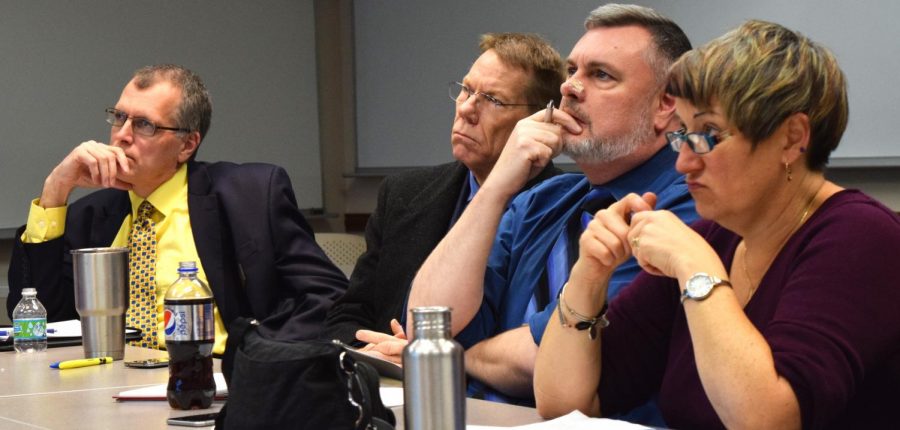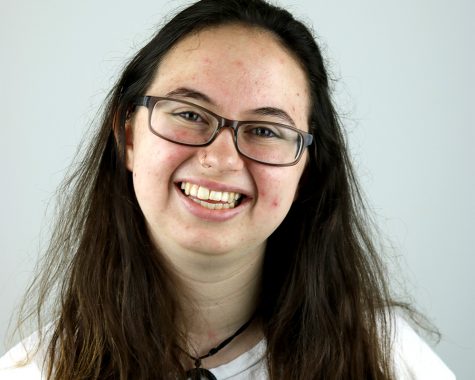Workgroup Review Committee to submit final report
Brooke Schwartz | The Daily Eastern News The Workgroup Review Committee was staffed back in October and was tasked with looking back at suggestions made by last year’s Workgroups no. 8 and 9. With their deadline approaching, the committee will be uploading their final recommendations Tuesday at noon on the committee website goo.gl/5Tf55q.
January 15, 2018
The Workgroup Review Committee, which has been meeting since Oct. 20, will submit its final recommendations on Tuesday for Provost Jay Gatrell, Eastern President David Glassman and the rest of campus to see.
The committee will be making three overarching recommendations: the creation of an Eastern “signature experience;” a new five-college structure for the university; the development of alternative learning modules and tuition and a proposed timeline and some items for further consideration.
These recommendations will be on the committee’s website goo.gl/5Tf55q at noon.
The Eastern “signature experience” recommendation houses the proposals for a University College, which would be a one-stop building of academic programs, such as TRiO, Gateway, The Office of Study Abroad and more.
The committee is asking for more discussion on whether the addition of this college would affect the funding or integrity of the Sandra and Jack Pine Honors College, since the committee is recommending that the Sandra and Jack Pine Honors College takes in the University College.
Under the “signature experience” recommendations are also the proposals that the administration shows increased support for the development and creation of more interdisciplinary majors and courses, as well as the creation of a center for undergraduate research.
The five-college structure will be recommended with the creation of a health college and the combination of the school for continuing education and the graduate school, as well as many changes to other programs.
One example the group gave was that the new health college would possibly include programs such as health studies, kinesiology/sports studies, recreation administration, family and consumer sciences, communication disorders and sciences and nursing.
This plan would also include moving the School of Technology, which is currently located in the Lumpkin School of Business and Applied Sciences, over to the College of Sciences.
Included on the report’s timeline is the creation of many different academic programs, such as keeping the idea of an agriculture program in mind while hiring faculty over the next couple of years.
The report also includes a rejection of ideas from Workgroups No. 8 and 9 that the group almost unanimously decided to be wrong for Eastern, such as micro degrees and the addition of a Ph.D. program.
The “further considerations” section of the report includes two proposals which the committee felt it did not have enough time to fully discuss: the improvement of Eastern’s online academic services for faculty and students and the idea of a continuing vitalization committee.
A third item the committee originally thought was in need of further consideration was deleted after some discussion at Friday’s meeting — the proposal to discuss a seven-college system at Eastern.
The committee is officially proposing the idea of a five-college structure. Many worried that a seven-college recommendation would distract from the other suggestions the committee is making.
Institutional repository librarian Todd Bruns said he echoed the worry that focusing on a seven-college plan would draw attention away from the other recommendations they were making.
“I think that there’s some value (to a discussion about a seven-college structure) but I think that this paragraph is a potential lightning rod that kind of actually undercuts the whole process,” Bruns said. “I think (we should) get rid of this (seven-college proposal) and focus on a long-term ongoing revitalization committee. That committee, if it’s established, would be the one that would look at these further questions.”
Many agreed with Bruns, and the seven-college proposal will be left out of the further considerations section on the final draft of the recommendations. More time was devoted to talking about the potential ongoing vitalization committee, which was brought up at a Faculty Senate meeting, with support from members.
Many felt the name would have to be changed and would not include the term ‘vitalization,’ but the idea itself was left in the final draft of the recommendations.
“In my mind, if we had this committee years ago, when our enrollment started to drop, this committee would’ve said, ‘Hey, what’s going on here?’” Bruns said. “How did we have years and years and years of not spending the same amount on marketing as other institutions do, and no one caught this? … In my mind, that’s what this committee would essentially be about.”
Another aspect of the campus the committee will recommend being looked at is the technology used for academics by faculty and students.
The Center for Academic Technology Support has been defunded over the years. Many on the committee saw the importance of bringing CATS back into the state it was when Eastern first adopted it.
Overall, the committee said they tried to be as feasible as possible while still trying to start discussions on campus and not focus too much on how the details of each recommendation will play out.
Brooke Schwartz can be reached at 581-2812 or at [email protected].




















































